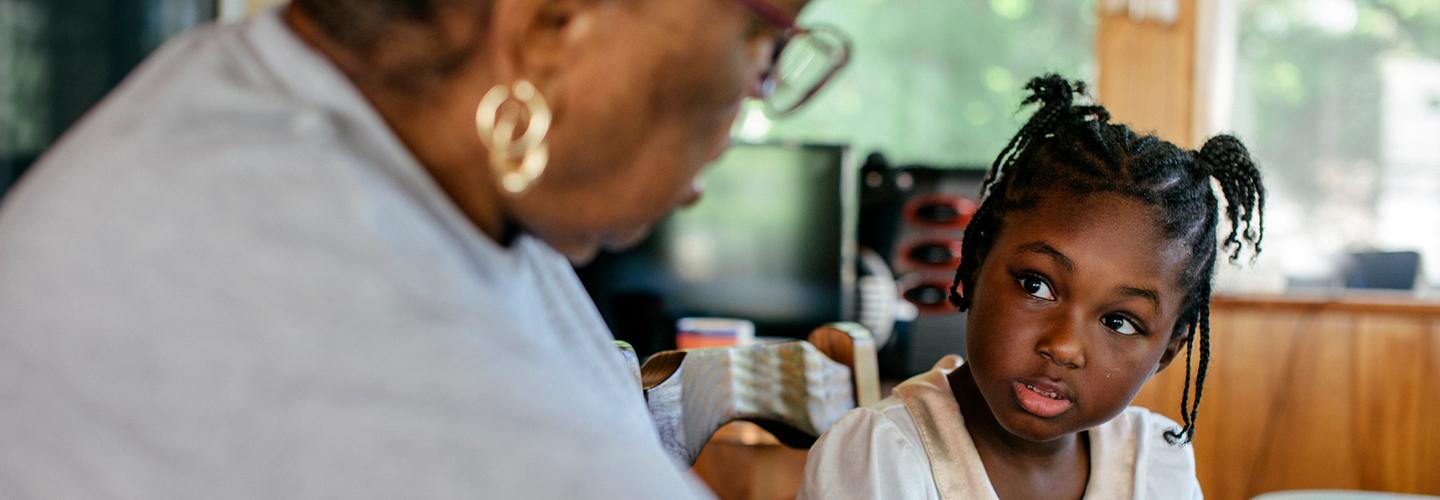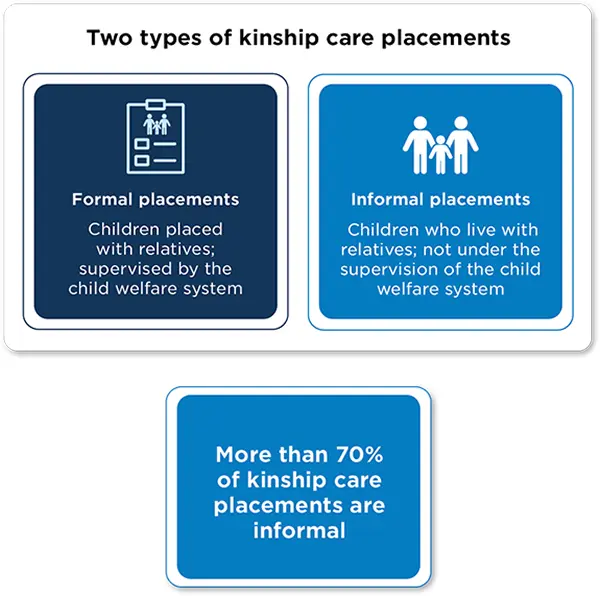
Kinship Care Supports the Academic Performance of Children
Children and youth who successfully learn how to read, write, and perform basic math skills are more likely to go to college, find good jobs, and attain financial security in adulthood—all of which support their overall well-being across the lifespan. Unfortunately, many children in out-of-home care (OOHC) have academic difficulties—including with basic elements related to core reading and math skills. However, recent research suggests that one way to improve academic outcomes and long-term success for children in OOHC is to allow them to live with relatives or other individuals with whom they have a close bond, in what is known as kinship care.
This brief summarizes the main findings of a study based in North Carolina and conducted by the first author of this brief, Tyreasa Washington, and her colleagues. The study reinforces that kinship care settings support the academic well-being of children who do not live with at least one birth or adoptive parent.
Context
Kinship care refers to the placement of children with relatives or persons who have a close bond with the children (e.g., grandparent, aunt or uncle, Godparent, church member) when birth parents are unable or not willing to be the primary caregiver. In recent years, child welfare advocates, practitioners, researchers, and policymakers have increasingly advocated for the placement of children in OOHC with kinship caregivers. Research and observations indicate that children placed with kin tend to have better academic, behavioral, and mental health outcomes—as well as an increased sense of family connectedness and belonging—compared to children who are placed in traditional non-relative OOHC (i.e., foster care).
In 2013, approximately 2.2 million U.S. children were in some form of kinship care. Census data tell us that the number of children in kinship care has increased over the last few years to approximately 2.6 million children. There are two types of kinship care placements: formal and informal. In formal kinship care placements, children are placed with relatives and these families are supervised by the child welfare system. Informal kinship care families are not supervised by the child welfare system. It is important to note that the majority of children in kinship care are informally placed: At any given time, more than 70 percent of kinship care placements are informal.

Methods
The recently published study includes the assessment of academic skills of several groupings of children in OOHC, including informal kinship placements. The inclusion of children in informal kinship care in research is new(er) to the field because this is a difficult population to reach despite the fact that these informal placements comprise the majority of kinship care placements. The study also includes the use of standardized test scores to access children’s academic skills as opposed to subjective measures such as teachers’ and parents’ reports.
For this study, researchers combined data from North Carolina’s education and child welfare systems from 2009-2013 to evaluate the academic well-being of third-to-sixth-grade children in kinship care (both formal and informal) and non-relative foster care, as compared to children who reside with at least one birth or adoptive parent. Data from a total of 519,306 children were included in the study—with approximately 8,000 children in the sample having experienced some form of OOHC during the study period. Researchers examined scores from end-of-grade math and reading scores to determine whether children were achieving at grade level.
Findings
This study produced two exciting findings.
First, among children in OOHC, children in both formal and informal kinship care fared better academically than children in non-relative foster care, particularly with respect to math scores. This finding makes sense in light of the extensive body of research suggesting that children removed from parents and placed with non-relative foster caregivers are subject to significant trauma; this trauma may be less significant among children placed in kinship care. Additionally, children who reside in kinship care are better able to maintain connections to family, benefit from cultural continuity, and experience placement stability—all of which can play a role in supporting key developmental outcomes, such as academic success.
Second, children in formal kinship care performed best among all children in any form of OOHC; in fact, their performance was similar to that of children living with their birth or adoptive parents. This finding is incredibly exciting, as it suggests that formal kinship care may be one of the only known interventions that helps to eliminate the widely observed deficits in academic functioning among youth in OOHC. When considering the reasons why formal kinship care may be more beneficial to academic performance than informal kinship care, it is important to recognize that one of the main distinctions between formal and informal kinship care is that formal kinship care often comes with a suite of resources, services, and funding that is rarely provided to informal kinship families. As such, the authors of this study believe that the addition of resources—not more involvement of and supervision by the child welfare system—is the reason that formal kinship care seems to support students’ academic performance.
Recommendations
Based on these findings, we offer the following three recommendations for supporting the academic success of children in OOHC:
First, kinship care should be considered a strategy for promoting academic well-being for children in OOHC. In addition to placing these children with kin, it is also vital to provide services and resources to optimize children’s academic success. This research does not suggest that children benefit from being removed from parents or being placed in the child welfare system, nor does it suggest advocacy for more surveillance and oversight. Nevertheless, when children must be removed from parents, this research does suggest that kinship placements are best.
Second, we recommend prioritizing kinship care over other placement alternatives whenever possible. Kinship care produces multiple positive outcomes, including better academic, behavioral, and mental health outcomes; increased placement stability; and children’s greater ability to maintain contact with their birth parents and families.
Third, we recommend kinship care as one way to reduce the overrepresentation of children of color in the child welfare system, particularly among Black and Native American children. Child welfare agencies and other systems (e.g., criminal justice, education) should consider engaging kin and diverting children to kinship care before recommending state custody. However, access to services and resources must be provided to ensure the safety and well-being of all family members.
Ultimately, kinship care families who are participating in these living arrangements (i.e., those with lived experience) should have opportunities to offer ideas to child welfare agencies, researchers, policymakers, and other stakeholders that they believe could promote children’s academic performance and overall family well-being.
We would like to acknowledge and thank the authors of the article that served as the basis for this brief.
Suggested citation
Washington, T., & Mihalec-Adkins, B. P. (2023). Kinship care supports the academic performance of children. Child Trends. https://doi.org/10.56417/6688s365k
© Copyright 2024 ChildTrendsPrivacy Statement
Newsletter SignupLinkedInThreadsYouTube